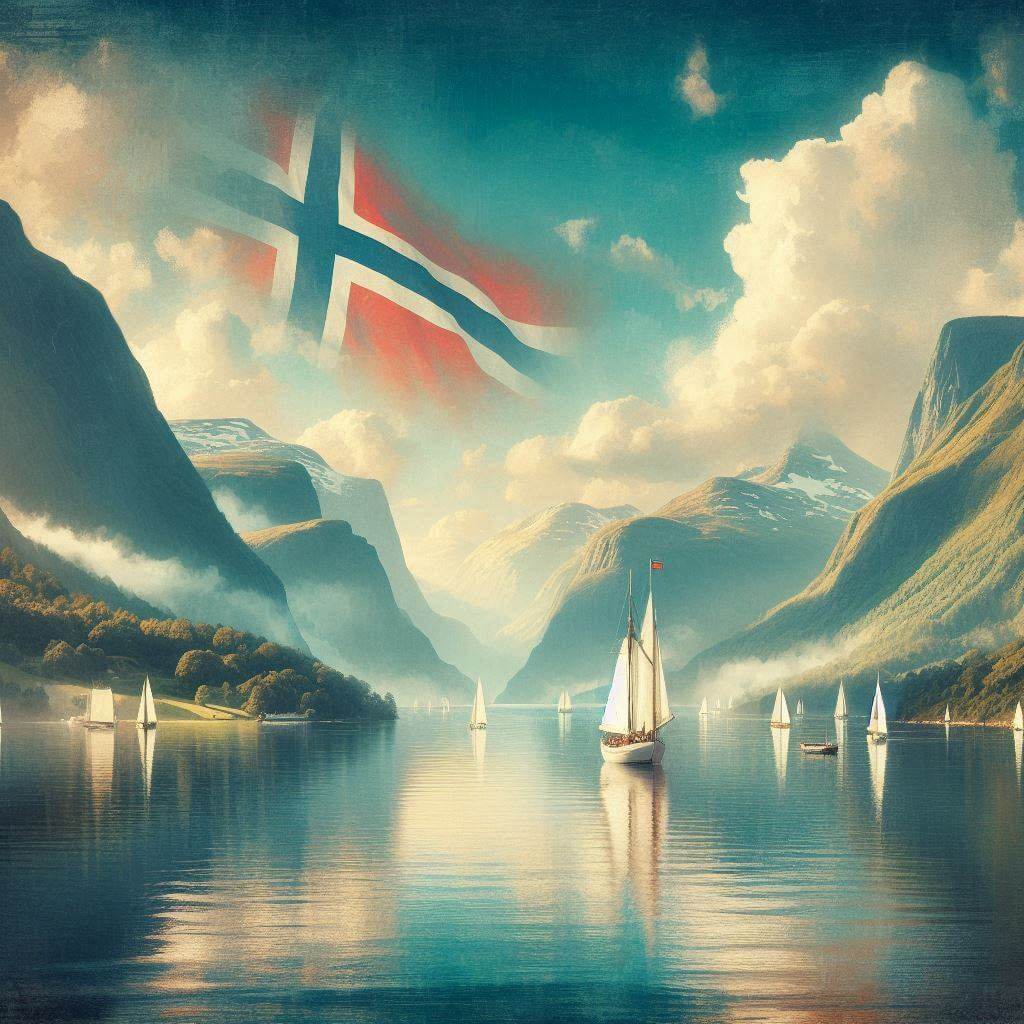The flag of Norway, known as the "Dannebrog," features a vibrant red field with a blue Nordic cross outlined in white that extends to the edges of the flag. This iconic design, shared in various forms by other Nordic countries, reflects Norway's rich history, cultural heritage, and regional ties.
Norway information
| National Flag Day | May 17th |
| Sovereign state | Yes |
| Official name | Kingdom of Norway |
| Capital | Oslo |
| Population | 5,347,774 |
| Area | 323,802 km² |
| Currency | Norwegian krone (NOK) |
| Language | Norwegian (Bokmål and Nynorsk) |
| Continent | Europe |
| Region | Northern Europe |
| Subregion | Scandinavia |
| Borders | Sweden, Finland, Russia |
| Timezone | Central European Time (CET) UTC+1 |
| Calling code | +47 |
| Top-level domain | .no |
History of the Norwegian Flag
 The current design of the Norwegian flag was officially adopted on July 17, 1821, shortly after Norway gained independence from Denmark. However, its roots trace back to 1318 when the coat of arms of Norway featured a golden lion on a red field. The Nordic cross design was inspired by the Danish flag, acknowledging the countries' shared history under the Kalmar Union.
The flag's adoption marked a significant milestone in Norway's journey towards full independence, which was finally achieved in 1905 after the dissolution of the union with Sweden. Throughout its history, the flag has symbolized Norway's struggle for sovereignty, its democratic values, and its distinct national identity.
The current design of the Norwegian flag was officially adopted on July 17, 1821, shortly after Norway gained independence from Denmark. However, its roots trace back to 1318 when the coat of arms of Norway featured a golden lion on a red field. The Nordic cross design was inspired by the Danish flag, acknowledging the countries' shared history under the Kalmar Union.
The flag's adoption marked a significant milestone in Norway's journey towards full independence, which was finally achieved in 1905 after the dissolution of the union with Sweden. Throughout its history, the flag has symbolized Norway's struggle for sovereignty, its democratic values, and its distinct national identity.
Symbolism and Design of the Norwegian Flag
The Norwegian flag's design is rich in symbolism, reflecting the country's history, values, and natural beauty. The red background represents the blood shed for Norway's independence, as well as the country's vibrant spirit and the warmth of its people. It also pays homage to the historical coat of arms featuring a red field. The blue Nordic cross, outlined in white, carries multiple layers of meaning. Primarily, it symbolizes Norway's Christian heritage, dating back to the country's conversion in the 11th century. The blue color is often associated with the country's fjords, clear skies, and the freedom that Norwegians hold dear. The white outline of the cross represents peace, honesty, and the snow-capped mountains that characterize much of Norway's landscape. The Nordic cross design itself connects Norway to its Scandinavian neighbors, reflecting shared cultural and historical ties while maintaining a distinct identity through its unique color combination.
Usage and Significance of the Norwegian Flag
 The flag of Norway holds immense importance in Norwegian society and is a source of great national pride. It is prominently displayed on government buildings, schools, and private residences, especially during national holidays and celebrations. The most significant of these is Constitution Day on May 17th, when the streets of Norway are awash with flags and the traditional red, white, and blue bunting.
Internationally, the Norwegian flag represents the country at diplomatic functions, sporting events, and global forums. It's a symbol of Norway's commitment to democracy, human rights, and international cooperation, values for which the country is widely respected on the world stage.
The flag also plays a crucial role in Norway's maritime tradition. As one of the world's leading shipping nations, the Norwegian flag is a common sight on vessels around the globe, symbolizing the country's seafaring heritage and modern maritime prowess.
The flag of Norway holds immense importance in Norwegian society and is a source of great national pride. It is prominently displayed on government buildings, schools, and private residences, especially during national holidays and celebrations. The most significant of these is Constitution Day on May 17th, when the streets of Norway are awash with flags and the traditional red, white, and blue bunting.
Internationally, the Norwegian flag represents the country at diplomatic functions, sporting events, and global forums. It's a symbol of Norway's commitment to democracy, human rights, and international cooperation, values for which the country is widely respected on the world stage.
The flag also plays a crucial role in Norway's maritime tradition. As one of the world's leading shipping nations, the Norwegian flag is a common sight on vessels around the globe, symbolizing the country's seafaring heritage and modern maritime prowess.
Interesting Facts About the Norwegian Flag
- Norway has specific rules about flag etiquette, including times for raising and lowering the flag and proper disposal methods for worn flags.
- The Norwegian flag inspired the design of Iceland's flag, showcasing the strong cultural connections between Nordic countries.
- During World War II, the flag became a powerful symbol of resistance against Nazi occupation, with miniature flags worn as patriotic emblems.
- The proportions of the Norwegian flag are not fixed by law, allowing for variations in shape while maintaining the basic design.
- Norway's flag is often referred to as "the red, white, and blue," similar to other nations' flags, but its unique design and shade of blue make it instantly recognizable.